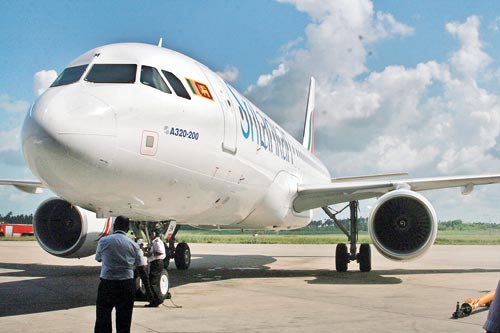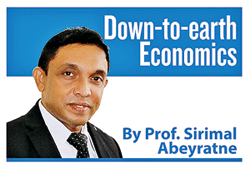SOEs and their “non-existent” owner
View(s):
File picture of a SriLankan Airlines plane. The airline is part of the SOE reforms
A few weeks ago, I had to deliver a special speech on “State-Owned Enterprise (SOE) Reforms” at the Auditorium of the Finance Ministry. The event had been organised by the Trade Union Relations division of the Presidential Secretariat, while the Minister of Power and Energy, Kanchana Wijesekera chaired it.
During the speech, I posed two questions to the audience, comprising representatives of trade unions, civil organisations, media and others. The questions were:
1. How many SOEs are there in Sri Lanka?
2. Who does own these SOEs?
Although the two questions appear to be seemingly too simple, it is not that easy to find correct answers to them.
Question of public assets
Let’s begin with the more fundamental question of the two – who owns the SOEs? It is true that, in theory SOEs belong to the “public” just as someone from the audience pointed out. However, it is not a pragmatically sound answer, because we cannot call upon somebody called “public” to represent “ownership interests” of a SOE.
One of the occasions that we have observed practical usage of the term “public assets” is that when such slogans are written on placards used by lobbying groups in their public protests. Another instance is the election campaigns, when some candidates refer to “public assets” telling the public that “such assets shall not be sold” if they would be voted to power. The “public” too has entrusted them with power, but nothing good seems to have happened to the public, even though the public assets continue to remain as public assets.
 It is always a “proxy” that has the legitimate authority to represent public interests, but it is a big question whether this proxy represents public interests or the proxy’s own interests.
It is always a “proxy” that has the legitimate authority to represent public interests, but it is a big question whether this proxy represents public interests or the proxy’s own interests.
In any business organisation, owners or the shareholders hire “agents” to work and fulfill their ownership interests. These agents are the managers and employees of the company. They also have their own interests which must be fulfilled by working for the owners’ interests, and not otherwise. Therefore, these agents are accountable to the owners.
The problem with SOEs is that there is no clearly identified owner! The government, the ministry, the politician, directors, managers, employees, they all exhibit characteristics of the “agent” who may not have the requirement to work for an “invisible” owner, raising the issue of accountability.
Number of SOEs
One could search the official records to find the number of SOEs in Sri Lanka, but I am sure there is no “accurate” answer. It’s not easy to count them either, because any number counted would lead to a dispute.
The Annual Report 2022 of the Department of Public Enterprises (DPE) records the existence of “almost” 300 SOEs. The Advocata Institute in its recent SOE survey reported 399 SOEs, while together with their subsidiaries this number rises to 527. The question is a difficult one, not only because Sri Lanka does not have a proper record of their count, but also because of the difficulty of defining ‘enterprise’ as well as ‘state ownership’.
However, it’s not surprising to arrive at any number around 400 SOEs or around 500 with their subsidiaries, operating in
Sri Lanka. What really causes someone’s surprise is to note such an extraordinarily high number of SOEs in a so-called small country with 22 million people.
Apart from that, another surprise is that it is quite unusual to find such a big number of SOEs in a country that is said to have followed “open economy” policies for over 45 years. Along with open economy policies, in any country in Asia including the former Communist countries, the SOEs have been reformed and their number has declined. This is a powerful piece of evidence to say that Sri Lanka has not really been an ‘open economy’ in and of widespread rhetoric.
New economy with old amenities
The SOEs born and assigned to play a major role in developing countries under their ‘closed economy’ regimes existed from the time of the Second World War to the 1980s. There was no matured private sector at the time. Besides, the influence of the USSR-led socialist camp during the Cold-War period and the protection and monopoly status under the ‘closed economy’ models, all had created fertile ground for breeding and multiplying SOEs.
The developing world began to replace their ‘closed economies’ with ‘open economies’ after the 1980s. In the open economy models, the SOE reforms were inevitable for a number of reasons. In the new economic model, the private sector plays a major role, while the government confines itself to undertake only a facilitating role.
The world found it difficult to move the economy fast with the newly-established open economy models combined with old-fashioned SOEs. It was necessary to introduce ‘efficiency and competition’, while the policies should not disrupt private business development, doing favours to public enterprises.
Large SOEs usually engage in supplying key inputs to private sector- led economic growth such as energy, transport, finance, telecom, port and shipping, aviation and airlines and material inputs for construction and industry. If such inputs are not available at international quality and price, then the whole economy is losing its global competitiveness.
Apart from the new requirements of the open economy model, SOEs everywhere typically carry fiscal burden on government budgets, increased non-performing loans, and contributions to growing public debt. It was evident that they are not capable of solving the external outcome of their internal issues by themselves, without undertaking reforms.
Economic and finance auditing
Sri Lanka’s problem is clear: It adopted the so-called ‘open economy’ but did not support it with SOE reforms. As a result, the people still carry the burden of hundreds of SOEs that were established mainly during the period of 1950s – 1970s.
One may also wonder where we would have found so many such ‘sectors’ in order to establish SOEs for each one. Interestingly, Sri Lanka has a wide range of SOEs operating from typical strategic sectors such as finance, energy, utilities, transport, and aviation to typical activities like salt, milk, cashew, paddy, tea, rubber, coconut, palmyrah and many others.
Out of the total number of SOEs, whatever their number may be, the government has earmarked “strategically important” 52 State-Owned Business Enterprises (SOBEs). Among these, 34 SOBEs reported profits in total Rs. 214 billion and the balance 18 made losses in total Rs. 959 billion in 2022.
While the government has to make annual transfers to meet recurrent and capital expenditure of the SOBEs, some of them also used to borrow from both domestic and foreign sources with government guarantees. By the end of 2022, their accumulated debt amounted to US$ 3,739 million which is part of the country’s public debt absorbed by the government.
Rest of the SOEs, which may be about 300-400 or even more, has no financial reporting available, according to the Advocata survey. Even if financial performance reporting is carried out, the economic-performance reporting remains a critical issue for the SOEs. It is because clean financial operations can be carried out as per the government’s administrative and financial regulations, but with no significant economic output or contribution.
Buzzword – SOE reforms
The term SOE reforms started making headlines in Sri Lanka in the recent past. First, it was due to the economic crisis in which our strategic SOEs failed to meet the demand creating supply shortages and long queues. Secondly, it is a major component of our proposed reform package needed for the recovery and progress.
For the whole crisis time, we have already seen the positive results of restructuring the petroleum distribution. Are we in a position to ensure that we would be embarking upon a successful SOE reform programme within the next couple of years, without halting it just with a mediocre outcome? There are no signs yet in order to give a sensible answer to that question.
(The writer is a former Professor of Economics at the University of Colombo and can be reached at sirimal@econ.cmb.ac.lk and follow on Twitter @SirimalAshoka).
Hitad.lk has you covered with quality used or brand new cars for sale that are budget friendly yet reliable! Now is the time to sell your old ride for something more attractive to today's modern automotive market demands. Browse through our selection of affordable options now on Hitad.lk before deciding on what will work best for you!


